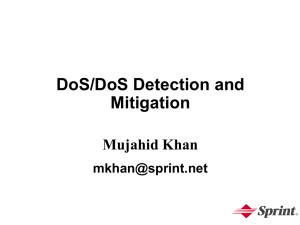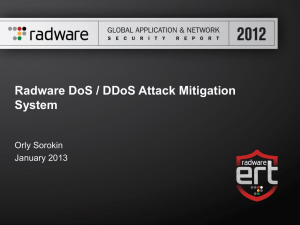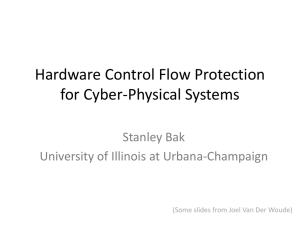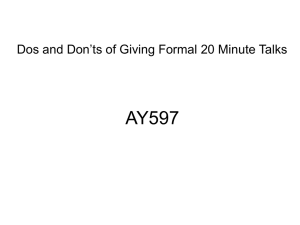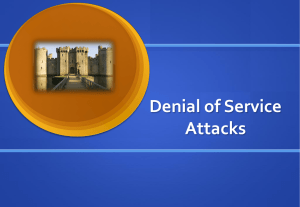DoS Attacks
advertisement
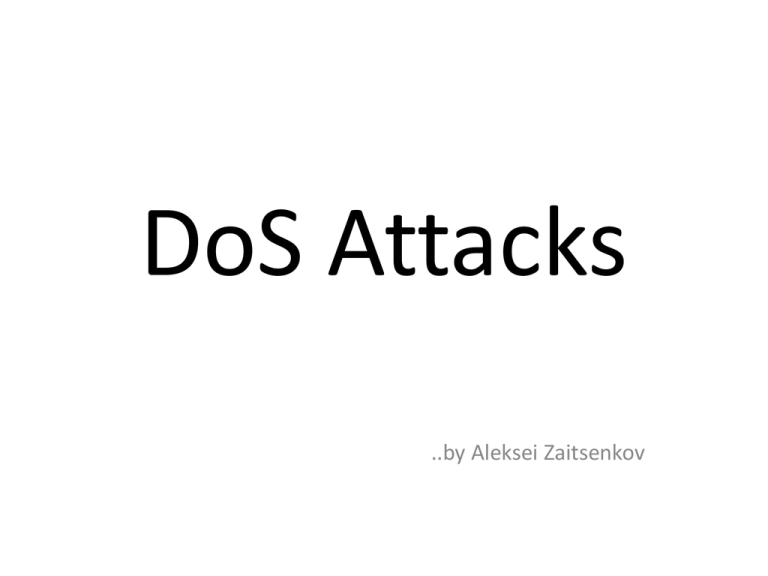
DoS Attacks ..by Aleksei Zaitsenkov OUTLINE • • • • • • • “DoS Attacks” – What Is History Types of Attacks Main targets today How to Defend Prosecution Conclusion WHAT IS “DOS ATTACK” Denial-Of-Service Attack = DOS Attack is a malicious attempt by a single person or a group of people to cause the victim, site or node to deny service to it customers. • DoS = when a single host attacks • DDoS = when multiple hosts attack simultaneously ATTACK SIZE IN GBITS-PER-SECOND ATTACK SIZE IN GBITS-PER-SECOND IDEA OF “DOS ATTACKS” • Purpose is to shut down a site, not penetrate it. • Purpose may be vandalism, extortion or social action (including terrorism) (Sports betting sites often extorted) • Modification of internal data, change of programs (Includes defacement of web sites) HISTORY Morris Worm (November 2, 1988) • First DDoS attack to cripple large amounts of network infrastructure • Self-replicating, self-propagating. • Exploited software commonality (monoculture) 1. 2. 3. Fingerd buffer overflow exploit Sendmail root vulnerability Weak passwords HISTORY Morris Worm effect • Infected systems became “catatonic” • Took roughly three days to come under control • Ultimately infected 10% of Internet computers (6,000) and cost $ million to clean up. • Morris convicted under computer fraud and abuse act, three years probation, fine of $10,000 HISTORY SQL Slammer (January, 25 2003) • Exploited common software (Microsoft SQL Server) as well as hardware (Intel x86), spread rapidly in a distinct monoculture. • Non-destructive. Modified no data on infected system • Extremely simple in construction (376 bytes) • Devastating: 1. 2. 3. 4. 120,000 computers infected at peak (1/26/2003) Exhausted network bandwidth Crashed network infrastructure (multicast state creation) Shut down communication (fire-fighting) capability HISTORY SQL Slammer effect • Extremely Virulent • Caused economic damage outside of IT infrastructure (multiple ATM outages) • Original perpetrators have never been identified or brought to justice TYPES OF DOS ATTACKS TYPES OF DOS ATTACKS • • • • Penetration Eavesdropping Man-In-The-Middle Flooding TYPES OF DOS ATTACKS Penetration • Attacker gets inside your machine • Can take over machine and do whatever he wants • Achieves entry via software flaw(s), stolen passwords or insider access TYPES OF DOS ATTACKS Eavesdropping • Attacker gains access to same network • Listens to traffic going in and out of your machine TYPES OF DOS ATTACKS Man-in-the-Middle • Attacker listens to output and controls output • Can substitute messages in both directions TYPES OF DOS ATTACKS Flooding • Attacker sends an overwhelming number of messages at your machine; great congestion • The congestion may occur in the path before your machine • Messages from legitimate users are crowded out • Usually called a Denial of Service (DoS) attack, because that’s the effect. • Usually involves a large number of machines, hence Distributed Denial of Service (DDoS) attack MAIN TARGETS ESTONIAN CYBERWAR APRIL 27, 2007 • Weeks of cyber attacks followed, targeting government and banks, ministries, newspapers and broadcasters Web sites of Estonia. • Some attacks took the form of distributed denial of service (DDoS) attacks (using ping floods to expensive rentals of botnets). • 128 unique DDOS attacks (115 ICMP floods, 4 TCP SYN floods and 9 generic traffic floods). • Used hundreds or thousands of "zombie" computers and pelted Estonian Web sites with thousands of requests a second, boosting traffic far beyond normal levels. ESTONIAN CYBERWAR APRIL 27, 2007 • Inoperability of the following state and commercial sites: – – – – – – – The Estonian presidency and its parliament. Almost all of the country’s government ministries. Political parties. Three news organizations. Two biggest banks and communication’s firms. Governmental ISP. Telecom companies. ESTONIAN CYBERWAR APRIL 27, 2007 • The attack heavily affected infrastructures of all network: – Routers damaged. – Routing tables changed. – DNS servers overloaded. – Email servers mainframes failure, and etc. ESTONIAN CYBERWAR APRIL 27, 2007 HOW TO DEFEND • Firewalls - can effectively prevent users from launching simple flooding type attacks from machines behind the firewall. • Switches - Some switches provide automatic and/or systemwide rate limiting, traffic shaping, delayed binding to detect and remediate denial of service attacks • Routers - If you add rules to take flow statistics out of the router during the DoS attacks, they further slow down and complicate the matter • DDS based defense • Clean pipes PROSECUTION • • • • Different governmental legislation Too expensive National interests Hard to prove who used the computer CONCLUSION • Role of international boundaries - consoles located across international borders, law-enforcement problem • In the past, as the present, DDoS has been more a nuisance activity conducted by cyber vandals than an activity with specific socioeconomic aims • In the future, DDoS may be used as a disruptive force, with broad destabilization as its aim instead of the targeting of specific targets • Destabilization has a high (ROI) Return On Investment when compared to targeted attacks QUESTIONS? People are talking about the Internet as though it is going to change the world. It's not going to change the world. It's not going to change the way we think, and it's not going to change the way we feel. Peter Davison
